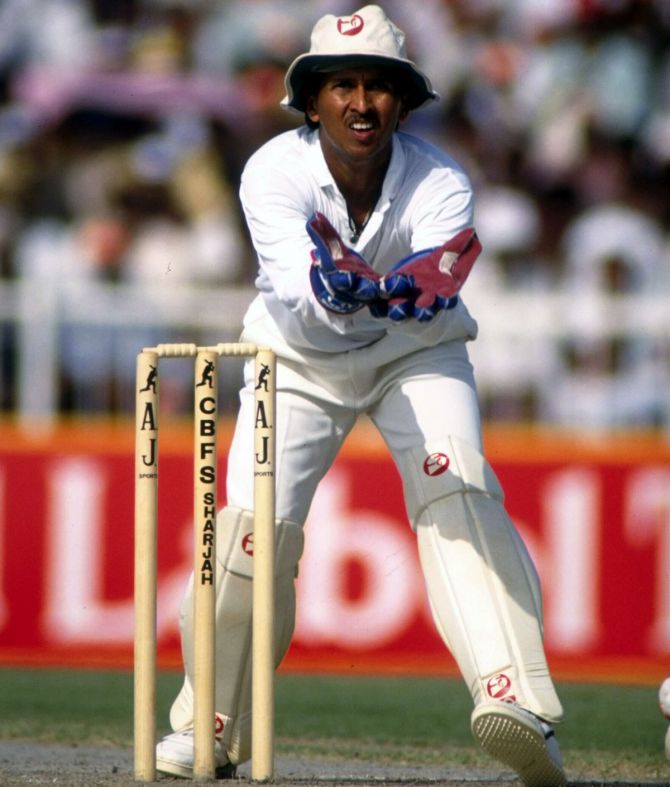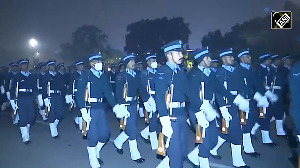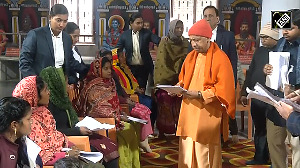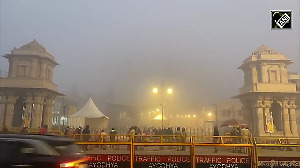'The West Indies' pace battery was lethal.'
'Watching Gavaskar, Gaekwad, Amarnath and Vengsarkar play against those bowlers I learnt so much.'
'Everybody was getting hit.'
'Someone got hit on the fingers, someone on the chest, someone on the face, but they all showed guts.'

Getting picked for India is a dream come true moment for every cricketer in the country and it was no different for Kiran More.
Even though the Baroda wicket-keeper-batsman, who was first selected for the tour of the West Indies in 1983 as the understudy to Syed Kirmani, spent nearly three years on the sidelines before playing his first match for India he has no complaints.
More remembers some memorable moments spent in the Indian dressing room in the company of legendary cricketers Sunil Gavaskar, Kapil Dev, Mohinder Amarnath and Dilip Vengsarkar among others.
His duties as the reserve player in the West Indies including keeping scores for the team, along with constantly carrying drinks out on the field or helping players during injuries or practice. Those days, teams didn't have support staff members like physios and fitness trainers.
More, who made his Test debut at Lord's in 1986, is the third most successful wicket-keeper in Test cricket for India, with 130 dismissals in 49 Tests from 1986 to 1993, including 110 catches.
He also played 94 ODIs, in which he was accounted for 90 dismissals.
His world record of six stumpings in a Test match, including five in an innings, in the Chennai Test against the West Indies in 1988 still stands.
One of the most memorable moments featuring More was his clash with Javed Mianded in the 1992 World Cup when the Pakistani batsman mocked the Indian wicket-keeper's style of appealing by jumping up and down.
For More, cricket always seemed like his destiny right from the very start.
Being born in Vadodara, a place known for greats Vijay Hazare, Hemu Adhikari, Gul Mohammad and Anshuman Gaekwad, cricket had always stoked his interest. And his family business of supplying food to teams during Ranji Trophy matches in Baroda further strengthened his resolve to take up cricket as his career.
In the third part of a multi-part interview, Kiran More tells Rediff.com's Harish Kotian what drew him to cricket as a youngster and what he learnt during his first tour with the Indian team to the West Indies.
- Part 1: 'Dhoni is very smart'
- Part 2: 'Dropping Ganguly was not easy'
What made you take up cricket -- and that too, wicket-0keeping which is the toughest job in cricket?
A lot of cricketers used to stay near my place in Shiyabaugh in Baroda. There were players who played for India, Ranji Trophy or Under-19 cricket, so every day I used to see a lot of cricketers coming and going after matches.
You used to hear in the locality that someone has got selected for India or in the Ranji Trophy team.
The great Vijay Hazare stayed close by, D K Gaikwad also stayed there. Vijay Hazare's house was right next to my school, they shared the same boundary wall.
I could see from my school window when he used to do gardening or take a walk in the compound, so that was some of my earliest inspiration.
Baroda is a small place, but it always had a good cricketing culture from the maharaja era. If you look at the list of players who hailed from Baroda it is quite a big list. You will find greats like Hazare, Hemu Adhikari, Gul Mohammad, and a lot of other cricketers.
My dad had a catering business and we used to supply lunch for cricket matches in Baroda so whenever any match was there, I used to go along with my dad to the cricket ground so the attachment was always there.
I used to get to see all the Baroda players up close and also get to see the matches free. Those days you had a ticket for first class matches, I think it was 50 paise for one day.
My sister Shyama, who was initially a kho kho player, was playing cricket for the Youth Service Centre club in Baroda. She started playing for the women's cricket team at the club and later went to play for the state as well.
The club was newly formed so we didn't have many players so we used to play combined -- five girls and six boys in one team.
The tournament was called thr Zaveri League and we beat quite a few teams. Some of them then objected saying that the girls should not be playing this tournament and the girls were banned from next year.
I remember playing for the club in my first match with the season cricket ball as we called it. I got 49 runs.
In that match, I was not keeping wickets, but somebody else was doing it for the club.
I have always kept wickets even though I could bowl leg spin. I stuck to keeping wickets because I enjoyed it.
You are always in the game when you are behind the wickets.
I then took part in school cricket. I remember we were playing ay one big maidaan in Baroda, where the selections for the state Under-19 team was happening.
One of the selectors (Jayasinhrao) Mamasaheb Ghorpade saw me keeping wickets. He called me and told me to come for the trials.
Even though the selection process was completed they saw me and told me to come next year or told me to try for the Under-22 trials.
So I went for the Under-22 trials and I got picked for the Baroda Under-22 team even though I was quite young.
Did your height help in wicket-keeping because we have seen in India wicket-keepers will smaller height have done well?
In India if you see the tall wicket-keepers find it a bit difficult. But overall if you see it is more of psychology, it is not that only short guys can keep wickets, the tall guys if they can manage they also have some advantages.
Earlier, a lot of people used to say that short guys can be good wicket-keepers. If you seem someone like Adam Gilchrist who is tall, but he was an excellent wicket-0keeper.
A lot of wicket-keepers from England, Australia or South Africa have been tall so height doesn't make a difference.
It is just a matter of how you adjust.
In India it is sometimes difficult especially when the ball keeps a bit low so you have to work on technique accordingly.
Your first tour with India was to the West Indies in 1982-1983 when you went as the understudy to Syed Kirmani. How much did you learn from that experience because you didn't play a single match on that tour?
It was a great experience.
When I was picked, I got the chance to be alongside greats like Sunil Gavaskar, Mohinder Amarnath, Anshuman Gaekwad, Dilip Vengsarkar, Madan Lal, Syed Kirmani.
When I was growing up I heard a lot about them and wanted to be like them and play for the country.
I had never seen a Test match live from the stadium, I had always seen the Test match on television or heard it on radio.
So the tour was the first time that I witnessed Test cricket live in Jamaica.
And I can never forget that match because the atmosphere in Jamaica is something special. The fans love their cricket and they understand the game very well.
The West Indies those days were led by Clive Lloyd and they had 6, 7 very good fast bowlers -- Malcolm Marshall, Andy Roberts, Michael Holding, Joel Garner, Colin Craft and others.
Those days you didn't have scorers or physios or masseurs. So as a reserve player, I had to do the scoring for the team and 12th man duties.
Once I could spot only 10 players from the West Indies on the ground. I was wondering where the 11th player was. I wrote 10 names on the scorecard and I was looking around for the 11th player.
I asked a gentleman sitting next to me. He was the great George Headley, also known as the 'Black Bradman'. He was sitting right next to me wearing a hat and smoking a cigar.
He then pointed out the 11th man. It was Michael Holding who was starting his run up from near the sightscreen.
I was shocked to see Holding's long run up, and that is how I got my 11th player on the scoresheet.
And in the middle, it was a great battle between the great Gavaskar and the West Indies fast bowlers.
Gavaskar was bowled for a duck in the second innings by Holding and the whole crowd erupted at once. That was a sight I will never ever forget.
In those days, getting Gavaskar early was a big thing for the West Indies bowlers because the Little Master loved to bat against their fast bowlers.
Gavaskar was very popular in the West Indies, they loved him a lot there, they used to call him the Little Master, they also wrote a song for him and whenever he went he got some much love from the fans.

How was it for 21-year-old Kiran More in the Indian dressing room in the company of greats like Gavaskar, Kapil Dev and others?
That 1983 tour of the West Indies was great for me, the senior players looked after me well.
You had Hanumant Singh as our manager, he was very helpful. There were quite a few young players -- Laxman Sivaramakrishnan, Maninder Singh, Gursharan Singh. Someone like Balwinder Singh Sandhu was not that senior.
The tour was a big learning experience. I could see that Test cricket is tough and one needed to be mentally strong because dealing with the West Indies fast bowlers was not easy.
I learnt that every session is different and challenging and the sessions could change in a matter of 5 to 10 overs.
In those days, the West Indies were one of the best teams of that generation and their pace battery was lethal.
So just by watching Gavaskar, Gaekwad, Amarnath and Vengsarkar play against those bowlers I learnt so much.
Everybody was getting hit. Someone got hit on the fingers, someone on the chest, someone on the face, but they all showed guts.
In the evening, our dressing room was like the hospital. Those days we didn't have a team doctor so we helped each other.
I learnt an important lesson on that tour -- in cricket you need to be brave. You need to know how to play fast bowling else you won't survive in Test cricket.
That series showed me that Test cricket is at a completely different level from domestic cricket. It was a big wake up call for me.
You spent a couple of years under Syed Kirmani before you took over the gloves in 1986. How much did you learn from him?
I learnt a lot from him. I used to watch him closely as what he does in the dressing room before the match, how he prepares for the match and other things.
You learn a lot by watching the experienced players. You can go and talk to them, but you also learn a lot by observing people.
He had his own way of keeping wickets and I had my own style with the gloves.
But how he used to prepare, how he used to keep wickets in different sessions, and what he did at the end of play, all that I observed very closely.
I also used to watch the greats like Gavaskar, Amarnath, how they prepared for the match, how they got into the zone when they went into bat.
I also used to watch the opposition and interacted with a lot of them.
And let me tell you when you do the scoring in Test matches, you learn so much because you are watching every ball.
Any youngster who wants to watch cricket, they should do the scoring, I would say that is the best way to learn.












 © 2025 Rediff.com -
© 2025 Rediff.com -